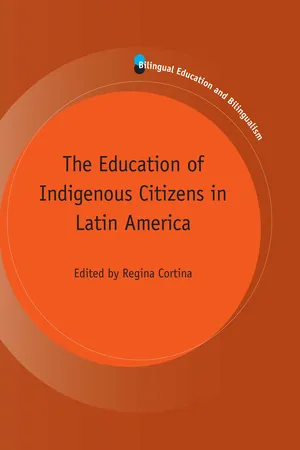
- 224 pages
- English
- ePUB (mobile friendly)
- Available on iOS & Android
The Education of Indigenous Citizens in Latin America
About this book
This groundbreaking volume describes unprecedented changes in education across Latin America, resulting from the endorsement of Indigenous peoples' rights through the development of intercultural bilingual education. The chapters evaluate the ways in which cultural and language differences are being used to create national policies that affirm the presence of Indigenous peoples and their cultures within Mexico, Ecuador, Peru, Bolivia and Guatemala. Describing the collaboration between grassroots movements and transnational networks, the authors analyze how social change is taking place at the local and regional levels, and they present case studies that illuminate the expansion of intercultural bilingual education. This book is both a call to action for researchers, teachers, policy-makers and Indigenous leaders, and a primer for practitioners seeking to provide better learning opportunities for a diverse student body.
Frequently asked questions
- Essential is ideal for learners and professionals who enjoy exploring a wide range of subjects. Access the Essential Library with 800,000+ trusted titles and best-sellers across business, personal growth, and the humanities. Includes unlimited reading time and Standard Read Aloud voice.
- Complete: Perfect for advanced learners and researchers needing full, unrestricted access. Unlock 1.4M+ books across hundreds of subjects, including academic and specialized titles. The Complete Plan also includes advanced features like Premium Read Aloud and Research Assistant.
Please note we cannot support devices running on iOS 13 and Android 7 or earlier. Learn more about using the app.
Information
| Table 1.1 Indigenous peoples, populations and languages in Latin America | ||||||
| Country and date of National Census | Total national population | Indigenous peoples | Indigenous population | Indigenous languages | Political status of Indigenous languages | |
| # | % | |||||
| Argentina (2001) | 36.260.160 | 30 | 600.329 | 1.6 | 15 | Languages of education |
| Belize (2000) | 232.111 | 4 | 38.562 | 16.6 | 4 | No recognition |
| Bolivia (2001) | 8.090.732 | 36 | 5.358.107 | 66.2 | 33 | Co-official with Spanish |
| Brazil (2000) | 169.872.856 | 241 | 734.127 | 0.4 | 186 | Languages of education |
| Chile (2002) | 15.116.435 | 9 | 692.192 | 4.6 | 6 | Languages of education |
| Colombia (2005) | 41.468.384 | 83 | 1.392.623 | 3.3 | 65 | Co-official with Spanish |
| Costa Rica (2000) | 3.810.179 | 8 | 65.548 | 1.7 | 7 | Languages to be preserved |
| Ecuador (2001) | 12.156.608 | 12 | 830.418 | 6.8 | 12 | Of official regional use |
| El Salvador (2007) | 5.744.113 | 3 | 13.310 | 0.2 | 1 | No recognition |
| French Guiana (1999) | 201.996 | 6 | 3.900 | 1.9 | 6 | Languages of education |
| Guatemala (2002) | 11.237.196 | 24 | 4.487.026 | 39.9 | 24 | National languages |
| Guyana (2001) | 751.223 | 9 | 68.819 | 9.1 | 9 | Languages of education |
| Honduras (2001) | 6.076.885 | 7 | 440.313 | 7.2 | 6 | Languages of education |
| Mexico (2000) | 100.638.078 | 67 | 9.504.184 | 9.4 | 64 | Co-official with Spanish |
| Nicaragua (2005) | 5.142.098 | 9 | 292.244 | 5.7 | 6 | Of official regional use |
| Panama (2000) | 2.839.177 | 8 | 285.231 | 10.0 | 8 | Languages of education |
| Paraguay (2002) | 5.163.198 | 20 | 108.308 | 2.0 | 20 | Guarani as co-official |
| Peru (2008) | 28.220.764 | 43 | 3.919.314 | 13.9 | 43 | Of official regional use |
| Surinam (2006) | 436.935 | 5 | 6.601 | 1.5 | 5 | No recognition |
| Uruguay (2004) | 3.241.003 | 0 | 115.118 | 3.5 | 0 | No recognition |
| Venezuela (2001) | 23.054.210 | 37 | 534.816 | 2.3 | 37 | Co-official with Spanish |
| Latin America | 479.754.341 | 661 | 29.491.090 | 6.1% | 557 | |
| Sources: Adapted from Tables 3 and 6 in López (2009). Notes: Although official, this information must be considered with caution since many technical and sociological problems persist in census data collection. Due to the subaltern condition of Indigenous societies, and also as part of a resistance strategy, many Indigenous individuals deny their ethnic affiliation and even the language they speak in order to present themselves as mestizos or Spanish or Portuguese speaking. In other cases, data collectors themselves, on the basis of their own perceptions and prejudices, decide who is to be registered as Indigenous or even as an Indigenous language speaker. Other sources based on estimates and on nonofficial data refer to 40 or even 50 million Indigenous inhabitants in Latin America (10% of the total population) (see López, 2009). | ||||||
Table of contents
- Cover
- Title
- Series
- Half Title
- Copyright
- Contents
- Acknowledgments
- Contributors
- Introduction
- Indigenous Intercultural Bilingual Education in Latin America: Widening Gaps between Policy and Practice
- Partnerships to Promote the Education of Indigenous Citizens
- Intercultural Bilingual Education in the Andes: Political Change, New Challenges and Future Directions
- The Tension between Western and Indigenous Knowledge in Intercultural Bilingual Education in Ecuador
- Indigenous Students as Graduates of Higher Education Institutions in Mexico
- Beyond Cultural Recognition: Training Teachers for Intercultural Bilingual Education in Guatemala
- Indigenous Leaders and the Challenges of Decolonization in Bolivia
- Political Discourse and School Practice in Multilingual Peru
- Author Index
- Subject Index